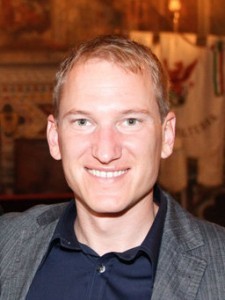2012 Young Investigator Award Finalist: Michael Groessl

Nominee:
Nominated By:
Supporting Comments:
Bioanalysis Zone asked Michael to highlight one of his favorite published articles and explain his reasoning.
Groessl M, Hartinger CG, Polec-Pawlak K, Jarosz M, Keppler BK. Capillary electrophoresis hyphenated to inductively coupled plasma-mass spectrometry: a novel approach for the analysis of anticancer metallodrugs in human serum and plasma. Electrophoresis 29(10), 2224–2232 (2008).
What were the most difficult challenges encountered in this study? And how were they overcome?
Online coupling of capillary electrophoresis and ICP-MS is very challenging owing to minute sample volumes (in the nanoliter range) combined with low flow rates. In addition, human serum represents an extremely complex sample matrix with a high protein content, which usually leads to irreproducible separations. These challenges were overcome by utilizing a sophisticated coupling interface and dynamic modification of fused-silica capillaries that lead to stable and robust separation of intact proteins.
What made you decide to study this particular field of bioanalysis? What makes it so appealing?
I was always interested in working in the field of drug development, especially in mode-of-action studies of novel compounds in vivo. On the one hand, clinical samples present a great bioanalytical challenge owing to their complexity and therefore require the development of novel analytical methods. On the other hand, research results can often be directly correlated to the clinical outcome of a certain treatment scheme thus bridging the gap between the bioanalytical bench and the clinical bedside. This multidisciplinary approach allows being part of the ‘big picture’ and allows participating in the development of novel drugs that enhances the quality of life of patients.
In your opinion, how has the research conducted in this study advanced the field of bioanalysis (i.e., future implications)?
As it was the first application of capillary electrophoresis coupled online to ICP-MS for the determination of metal-based drugs in clinical serum samples, it opened up a novel route for investigating the biodistribution and pharmacological behavior of this compound class. Considering that platinum-based cisplatin is used in approximately one-third of all chemotherapeutic schemes in cancer treatment, and a series of other metal-based agents are under clinical investigation, the technique can be applied to a large number of clinically interesting samples. In addition, application of ICP-MS in oncology research was further promoted, helping to change it from a pure elemental detector to a powerful bioanalytical tool.
Colleague quotes
Here is what some of Michael’s friends and colleagues had to say about him.
Christian Hartinger, University of Auckland, New Zealand
In your opinion, what are this Young Investigator’s key attributes?
“Michael has always been looking to apply novel methodology to solve analytical questions. This combined with his general curiosity to solve unanswered questions is a key attribute any analytical chemist needs.”
How are these qualities highlighted in their research and day-to-day activities?
“Being highly open-minded allows Michael to try new things, being curious about the outcome, and therefore a highly passionate and dedicated young researcher.”
Outside the field of their bioanalytical studies, what does this nominee like to do in their spare time? Is there anything particular they like to talk about?
“Michael likes the mountains both in summer and in winter. Such as a mountaineer reaching for the summit, he aims for the best in his daily research routines. However, I remember an incidence when going downhill was not as smooth as desired.”
What separates this Young Investigation from other up-and-coming bioanalysts in their field? How will this aid them in the future?
“Michael has experience in a wide variety of methods, which is rarely found, and is permanently widening his method panel. This is a characteristic surely distinguishing him from other bioanalysts and one which will allow him in future to select the best suited method to tackle the most challenging analytical problems.”




